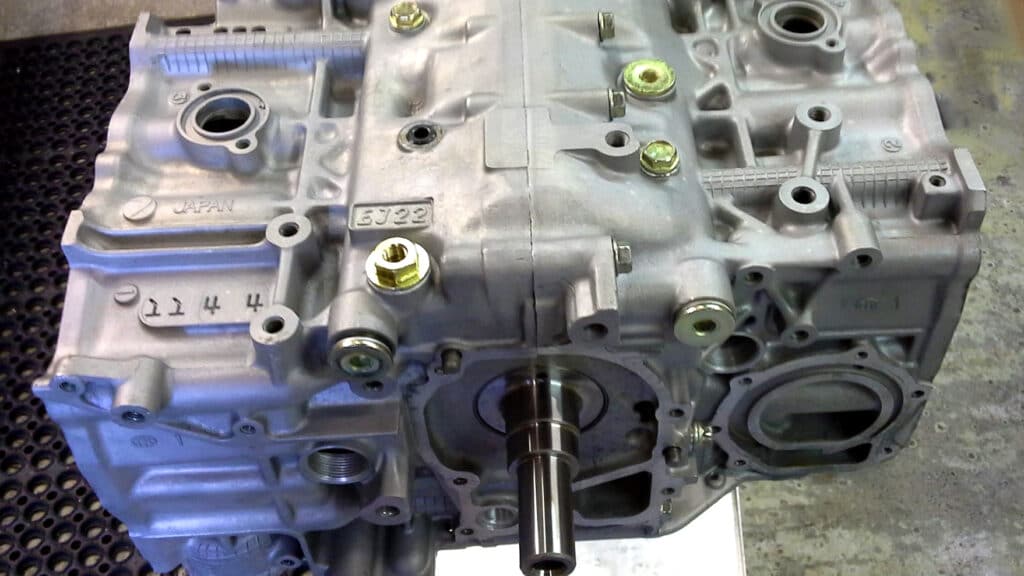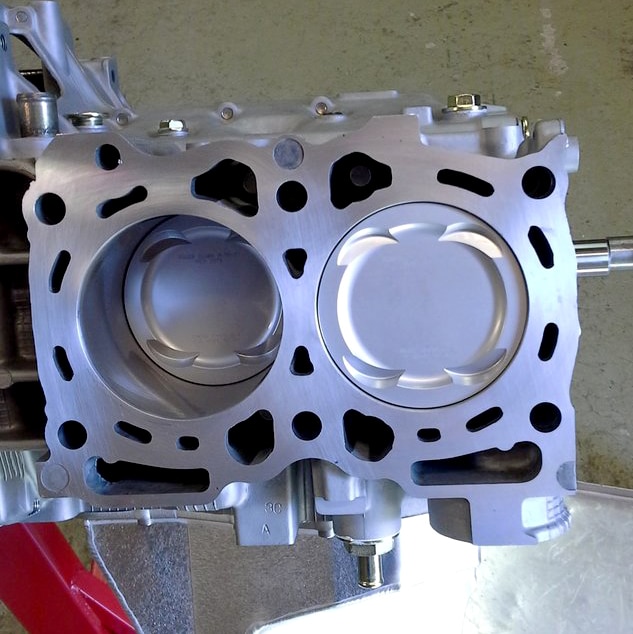Subaru introduced the EJ22 engine as a replacement for their old and aging EA platform. Available in naturally aspirated and turbocharged variants, the EJ22 was seen in the Subaru Impreza (1995-2001), Subaru Legacy (1990-1999), and Subaru Outback (1995-1996).
The EJ22E was developed with learnings from the EJ18 and EJ20. The 2.2l Subaru engine came with an incremental increase in power and durability. It was later given various updates to improve fuel economy and stay in line with the emissions regulations.
In this guide, we’ll focus on one of its turbocharged versions, specifically the EJ22T. Read on as we discuss the specs, reliability, and maintenance costs of the EJ22T engine, along with some information on swapping this engine into your car.
Subaru EJ22T Specs

- Engine Code: EJ22T
- Layout: Boxer 4 cylinder SOHC 16V
- Displacement: 2.2l (2,212 cc)
- Fuel System: Multi-point Fuel Injection
- Cylinder Bore: 96.9 mm (3.81 in)
- Piston Stroke: 75 mm (2.95 in)
- Compression Ratio: 8.1:1
- Power: 160 horsepower at 5,600 rpm
- Torque: 181 lb-ft at 2,800 rpm
- Firing Order: 1-3-2-4
The EJ22E started its life as an open deck engine that made 130 horsepower and 137 lb-ft of torque. The four-cylinder boxer engine came with all-aluminum everything, from the cylinder block up to the heads. EJ22 engine blocks have cast-iron sleeves, SOHC aluminum heads, and belt-driven camshafts. It ran a 9.5:1 compression, which was pretty impressive back when the engine was new.
As mentioned earlier, several iterations of the EJ22E were made available by Subaru. The EJ221/222/223 engines were improved phase 2 versions of the EJ22E available since 1997. The engine now puts out 142 horsepower and gets a 3% increase in fuel economy.
This comes courtesy of reduced engine friction. Thanks to the use of Molybdenum coated pistons that were 100 grams lighter, the EJ22 could deliver 10% more power. The improvements also helped increase durability and the engine was now running 9.7:1 compression.
However, this was a naturally aspirated motor. Imagine an EJ22E with a turbocharger, that’s the EJ22T. Almost all the internals of the EJ22 were carried over to the EJ22T with different pistons being the only exception. The turbocharged engine made use of low-compression dished pistons versus the EJ22E. The compression ratio was now 8.1:1 as opposed to 9.5 in the EJ22E.
Subaru Legacy from 1991 to 1994 made use of the EJ22T engine. In terms of specs, you’re looking at a phase one SOHC turbo that produces 160 horsepower and 181 lb-ft of torque.

The engine comes in a closed deck design with oil squirters and no intercooler. The EJ22T was made specifically for the North American market.
You get a 2,212cc engine, four valves per cylinder with 96.9 mm bore and 75 mm stroke. The engine weighs around 120 kilos and holds 4.8 quarts of oil with a viscosity of 10W-30.
How Reliable Is Subaru’s EJ22T?
When compared to some of its adversaries, Subaru is a bit behind when it comes to reliability. However, that’s not necessarily the case with all Subarus.
There are examples of Legacys and Outbacks touching 200k miles without any serious issues. It’s worth mentioning that mileage (in the context of old cars) isn’t an accurate metric when it comes to reliability.
The reason is that a high mileage car that’s been cared for could be far more reliable than a beat-up car that has done 80k. It goes to show you that if you take care of something, it’ll last.
As for the EJ22, though it’s no Toyota by any stretch, it gets a ton of positive reviews. The general consensus is to avoid the turbocharged EJ22T in fear that it’s stressing the engine.

But from a mechanic’s point of view, having a less complicated naturally aspirated engine is far easier and cheaper to maintain. On the contrary, if you don’t mind working on your car, then the EJ22T isn’t that bad of a choice. It’s not too intimidating and isn’t the most complicated either.
Considering the 22T is a closed deck design makes it more durable than its naturally aspirated counterpart. Also, it’s running a lower compression than the EJ22. But, Subaru was confident enough to ship the 22T without an intercooler.
We don’t side with that idea even if the engine is running lower compression and happens the strongest there is. However, an aftermarket electric radiator should fix it if that’s at all a concern.
If you can, find a car running this engine that doesn’t have an EGR valve, or plan ahead for an EGR delete kit. These are prone to fail eventually, so you can make your car much more reliable by doing away with it.
EJ22T Engine Swaps: Costs Involved
The average cost for an EJ22T engine swap will be based on how you shop. A used engine is worth around $200. But then you need to find a harness and all the auxiliaries. It also depends on the condition and availability.
There are only about 8,200 Subaru Legacys supplied to the North American market. Keep in mind that the EJ22T supports OBD 1, and is from an era when electronics weren’t all too common.
The most economical route is to source a whole donor car for under $500. This way, you have the engine, radiator, hoses, all of the wiring harness, and many more car parts.

The adapter plate is about $100 used. If it doesn’t come with the flywheel you are drilling the existing flywheel. A full-out harness is worth about $60 to $100, while a chopped and ready harness is worth about $300.
The more you can do yourself, the cheaper it will be. Labor is free if you have the time. Here’s the breakdown of some of the costs involved:
- $200-500 for the motor with harness and ECU.
- $200 for the adapter plate.
- $500 or thereabouts for the timing belt, water pump, plugs, wires, crank, and cam seals.
- $200 for radiator
- $185 for the clutch.
- $30 for waterproof electrical splices and a couple of fuse holders.
- $50 in radiator/heater hoses.
It comes to a total of $1,700. If you’re thinking of tuning the car, keep a buffer. Also, if you plan on running high boost pressures, make sure to invest in a quality intercooler, and forged pistons. The stock engine does not come with these and would significantly increase the cost of your build.
Should You Get an EJ22T?
Instead of opting for the EJ22T, you could simply turbocharge an EJ22E and swap the pistons for a forged set. But that way, you’ll lose out on the closed deck design and its benefits.

Closed-deck designs are more durable and can withstand more internal stresses. But, if you factor money, an EJ22E with a turbo running a relatively low boost pressure shouldn’t be that bad of an idea.
On the flip side, the EJ22E wasn’t intended for forced induction from the factory. Open decks (excluding the modern ones) aren’t made for boost. So you will end up replacing the major components every now and then.
At the end of the day, it all boils down to price and what you intend with your car. If you’re planning on boosting under 20 psi, go with whatever is the cheapest setup. The 22E is more common and cheaper than the 22T, but again it’s an open deck.
You’ll have to keep that at the back of your head every time you floor it. Knowing that the 22T could withstand a decent amount of beating does offer better reassurance and peace of mind.
To sum up, the EJ22T is not super reliable, nor is it a powerhouse. Then it begs the question, why would you want one in your car? We’d say the only reason you’d buy a 22T is for its uniqueness and rarity.
What are your thoughts on Subaru’s fully closed-deck turbo blocks? Let us know by leaving a comment below!


7 comments
The EJ22T was available in Japan in far greater numbers than in the US. That would be another source. In addition if it is a 1999 through 2001 motor it will have the Phase 2 upgrades. If you were swapping this into a VW Beetle the SOHC heads fit better, so there is that too. If you could get a JDM engine the EJ22G would be the one to get since it is closed deck and can be naturally aspirated or turbocharged. The turbocharged versions came with forged pistons. I have read in other reviews that the EJ22 is a very reliable engine.
The EJ22T was sold only in the US… JDM Legacy’s got the EJ20G.
Possible to swap an EJ22 into an EJ25 car like 2002 Legacy L Wagon Auto?
Is it possible to use the connecting rods and pistons from the Legacy EJ22 to swap into the Crosstrek FA20B to get about 10 to 27 more hp
The specs of the parts seem to suggest they are interchangeable. Any feedback would be appreciated preferably from someone who has done it.
I want to swap my EJ22E with an EJ22T in my 97 Impreza Outback Sport, but does anyone know where to source the engine? I could go to the Japanese market but I don’t want to pay an import cost. My 22E is on it’s way out and if I’m going to get a replacement might as well get a turbo right? As the article states, yes the 22E is very reliable as mine is currently at 215,449 miles and even though shes tired she is still running without many problems! But does anyone know where I could obtain an EJ22T?
I have an EJ22T and to its not that reliable but it is very fun.
I’ve had a EJ22T in my 89 Subaru RX since 2010. Running a TD04 @ 16psi and the only issues were when a cam end cracked and the headgaskets went when it overheated. In the last 2yrs I have done a complete rebuild, adding Delta cams, a VF39, 850cc inj and will be using a 95 WRX ECU for tuning. This is the biggest setback for the EJ22T, being able to tune the engine. You could go stand alone, but until somewhat recently, that wasnt feasible. Wish we could post pics here. @robbyrxii